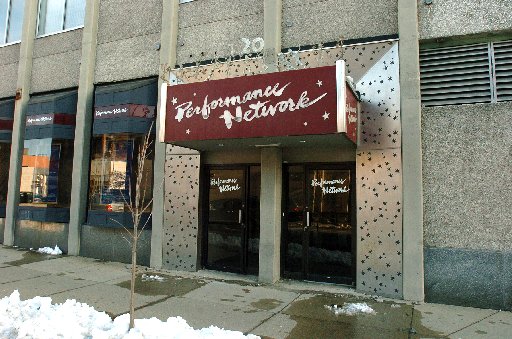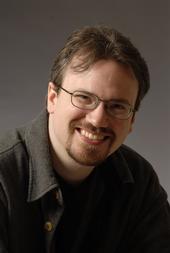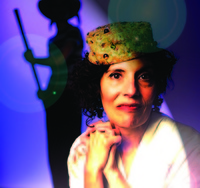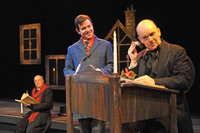Performance Network artists and supporters look back at the company's 30 year history

File photo
AnnArbor.com asked PN's founders, former administrators, artists, critics, and supporters to share their memories regarding the company's origin, evolution, and watershed moments, including its 2000 move from a now demolished industrial building at 408 W. Washington to its current home at 120 E. Huron; and its transformation from being a multi-media, black-box art space to a professional Actors Equity theater company.
Co-founder David Bernstein: In December 1981, a group of Ann Arbor actors who had worked together on the Ann Arbor Medieval Festival and at the Attic Theater in Detroit decided to mount the political farce, "We Won’t Pay! We Won’t Pay!" by the Italian actor/playwright Dario Fo, with the intent of touring it to community centers and union halls throughout Michigan. We were working with R. G. Davis, the founder of the San Francisco Mime Troupe, who had agreed to come to Ann Arbor to direct the play. While looking for a place to rehearse, we found a large room with a cement floor, cinder block walls and a pole dead center …at 408 West Washington, and decided that, cold and dank as it was, the room was adequate as a rehearsal space. Moreover, the rent was affordable. We rehearsed the show in that room and performed it there for three weekends in February of 1982—with no lobby, rented folding chairs, seating risers salvaged from the set of an Attic Theater production, and a noisy rooftop furnace fan right over the playing area. Amazingly, a few hundred people came to see the show at that raw warehouse space, which remained the Performance Network’s theater for years.
Was there a future for this facility as a performance space? Three of the members of the "We Won’t Pay! We Won’t Pay!" production team—myself, actor/producer Jim Moran and technical coordinator Ned Richardson—thought so. We joined three other partners to found the Performance Network as a multidisciplinary performance space, production company and community resource dedicated to socially-conscious, original, experimental and interdisciplinary work. The other partners were Ruth Bradley, then director of the Ann Arbor Film Festival, and Michael Perry and Linda Pantry, both of whom were veterans of the Ann Arbor film/video community. The composition of this partnership determined the content and style of our productions in the early years, when you were as likely to see a film screening, or a video installation, or an early computer-generated work at the Performance Network as a stage play. We often called the Network simply “the space” to emphasize its multiple uses and possibilities.
The six partners were joined by two more artists from "We Won’t Pay!"—technical director Ron Kramer and actress Judy Ottmar—and two independent Ann Arbor theater directors, Ron Miller and David Hunsberger. Within a few months, we incorporated as a nonprofit. So we were now a group of committed artists from several disciplines with a raw but promising space in which to do our work. But we had no money and only a vague idea of how we would use the facility in the coming months.
Then one afternoon in 1982, right after a freak April snow storm, several of us were sitting around on the empty seating risers (our rented seats had already been returned to A-1 Rental). The day before, we had set up at a UAW union hall outside Detroit for a touring performance of "We Won’t Pay! We Won’t Pay!," and we were waiting for word from the union about whether the performance would be canceled because of the weather. The door to the parking lot opened and in walked songwriter/folk musician, Jay Stielstra, whom I had never met. He said: "I hear there’s a guy named Bernstein who does plays here. I've put together a musical play called 'North Country Opera,' and I want to produce it." I told him that I was Bernstein and, yes, we’d consider producing his play. It became our first real "hit," with a cast that included Cheryl Dawdy and Connie Huber (who later became two of the three Chenille Sisters). That was the first of the many ways we found to keep the space alive in the early years.
But before we could legally perform to public audiences, we had to clear a couple of big hurdles. We needed more space for a lobby and backstage workspace, and we had to become legal as a performance space in the eyes of the City of Ann Arbor, whose zoning laws didn’t allow public assembly in that Old West Side industrial area. We got the zoning usage law amended to allow limited public performances and, when the room adjoining “the space” became available, we grabbed it. With local tradespeople contributing their skills and time, we did the code work necessary to get an occupancy permit from the city as a small performance facility, complete with lobby, work/office space, and of course, the original performance space with that famous pole sitting in the center, holding up the roof. And for more than a decade, that facility remained home to the Performance Network.
Co-founder Ron Kramer: That old factory was never comfortable. It was too hot or too cold or too wet (never too dry).
During rehearsals for the first show, "We Won't Pay, We Won't Pay," it was not uncommon to find coffee frozen solid when you came in the next morning. It got a little better once we insulated the windows and plugged the 2 inch gap in the SW corner where the side and back walls had parted company.
There was a running stream across the basement floor. From time to time, concrete would fall off the walls and clog the sump pump, resulting in 6-8 inches of water across the entire space. We had a lot of moldy scenery down there.
There were buckets hung from the ceiling near the pole in the center to catch the drips from the roof. The big worry was not water dripping on the stage or the front row of the audience, but whether the roof boards would rot and let the furnace fall through to the stage.
There were also flood plane issues. One morning, after a heavy rain, I drove by to find the dumpster floating out in the middle of the parking lot. The water was 3 inches deep on stage and cascading down the basement steps in the back room. The flood receded by noon, and with squeegees and mops, we got it dry enough for Young Peoples' Theater to put on a show later that day. Despite the adverse conditions, we did make a theater and, sometimes, people would endure the discomfort to see a show.
Former volunteer and administrator Linda Kendall Knox:
An interesting fact check … : PN did not inhabit the old American Broach building. The American Broach factory was operating across the parking lot, in a part of the building no one considered "connected" (actually we considered it "toxic"). In fact, the original PN founders helped the property owners transform all  the rest of the sprawling old building into the community-focused Technology Center (yes, that was the name of the building), intended to be an incubator for small businesses and artists who would collaborate on projects and share emerging technologies. The businesses were few (notably Clancy's Fancy Hot Sauce), and the technology was sparse, but artists thrived there for several years, contributing significantly to A2's culture.
… It was Performance Network's crazy diversity that originally drew me off campus. I brought my friends downtown to see modern dance, experimental film, and contemporary theater performances, all at prices we could afford. As I became a regular, and eventually a volunteer, I developed a great respect for the founders who worked so hard together, despite their political and aesthetic differences, to provide a truly "open stage" for community expression. The reward was a rich, constantly evolving intellectual environment. Most importantly for me, the theater seemed intensely connected to issues that were important to the people of our town. When I slid into a leadership role, I (we: Anne (Stoll), Joh (Broughton), Peter (Knox), Ron (Kramer), David (Bernstein) and so many more) aimed to keep that connection, through all the vagaries of the early 90's. Just one memorable moment: The Artistic Advisory Committee was meeting to decide whether or not PN should participate in this new Martin Luther King Junior Day concept, and if we did participate, what would we want to present, and with what commentary? It was a long, smoky night of debate, wherein we weighed the value and the danger in our nation's honoring this key leader on a a single day. I remember Elise Bryant, fabulously bright and eloquent as usual, ranting against it. That February, we produced an original play by OyamO entitled "The Meeting" - presenting a fictitious meeting between Dr. King and Malcolm X.
Former co-founding partner Ron Miller:
The Technology Center was a rather interesting maze of spaces. You really can't discuss the Performance Network without talking about the model the original group set up that really defined the entire development of the building. The Network was named … for the collective of artists and creative souls that inhabited this space. On the west end lower floors were the dance studios. I helped construct space for Whitley Setrakian and the first iteration of People Dancing though they built their own dance floors. Upper floors were private studios and artist spaces (homes). In the middle was the old print shop where we first printed Performance Network programs. I think it was run by a couple of wobblies (union industrial workers) whose names I can't remember. Right in the middle was Clancy's Fancy Hot Sauce, whose smell permeated the lower area. Not bad but interesting. Also there was someone who ran horse drawn carriage rides out of the facility. Rick Burns had, if not the original studio, surely one of the first. Towards the east end was an area we occasionally used to rehearse Network shows. And below it all, besides our "costume and prop" shop was beautiful Allen Creek, which regularly rose up to greet us.
The Network was a godsend for me, as I had just come back from New York and was desperately looking for something that better fit my theater training and interest. I was a product of experimental, avant garde and agitprop theatre, and though there was plenty of that in New York, I was more interested in seeing what could happen outside the big cities. What I found was this small group of people comprised of the most inventive, creative, quirky and irascible personalities you could possibly throw together in one room, all holing out in this dilapidated warehouse. (The Network was also a mattress or bedding factory at one time, if I'm not mistaken). Jim Moran, David Bernstein, Kathy Milar, Linda Pantree, Ned Richardson, BarbThorne, David Hunsberger, Ron Kramer, and a few other originals … all contributed tremendously to the vision. Linda Pantree led the fight for film and visual arts, along with Ruth Bradley and Michael Clarren. Most of us were theater people, but we were all about all the arts living under one roof. The whole idea behind the creation of the Performance Network was exactly what I was looking for, and though I could tell many significant stories around every play I ever directed or was in, … it still comes down to the the moment I first walked through the door and sat down with David Hunsberger to "talk theater." I had found my home. The Performance Network will always be my theater home, and anytime I find myself thinking about the significance of the arts to the local community, to the nation, and to the well being of the human spirit, this "thing" we created at the Performance Network will be my measuring stick. Economies and current attitudes make it extremely difficult for anything similar to happen, or at least to happen in the similar sprit; but I'm proud to have been a part of the creation of the Performance Network and wish it continued success. Â
Barbara Kramer:
The wonderfulness of the old Network was the sense of community. It was a true collective, with people doing theater, video and dance. One of my fondest memories was the day of the opening of "Tom Payne." A number of us were working frantically to finish up costumes. We had our kids on the floor, in playpens, or helping, if they were old enough. In the middle of this came a city committee bringing the mayor of our sister city in Nicaragua and his wife on a little tour. They looked at the chaos, needles flying and kids playing, and thought it was wonderful. My husband, Ron, and I met at the old Network (he was the technical director, I was the resident stage manager) and married in the midst of rehearsals for "Translations" (1985). Our oldest son spent his first months in his "Johnny Jump-up" suspended from a light pole in the theater. By the age of 3, he was running light levels for his dad. One last note: On the night before the very last performance in the old theater, I was sitting next to one of the producers of Mosaic Youth Theater, who was performing. She leaned over and said that she was really going to miss the old place. That night, we had very heavy rain, and when Ron checked the theater in the morning, it was flooded. The Mosaic actors were mustered, along with Network staff and volunteers, with many towels and mops, and we managed to get it cleaned up enough to go on with the show. I asked the producer if she was still going to miss the old place, and she said, "I guess not so much."
Theater artist Charles Sutherland:
The Performance Network was the "guerilla" theatre on the other side of the tracks. (Sutherland's longtime partner) Jim Posante got involved early, because he fancied working on new plays. He even was responsible for introducing (married couple and former PN directors) Johanna Broughton to Dan Walker! He acted in and directed experimental pieces there for years before I got involved. I remember him in a Garcia Lorca piece; "Huck and Puck," by Peter Knox and Linda Kendall (I did costumes, despite not understanding the play at all); with Malcolm Tulip in "Playing Bare" (a company playing "Waiting for Godot"); and Malcolm's one-man show, "Down the Plughole", changed my life.
I had to get involved. When Jim directed a new play, "Inverted Pyramid" (in 1998), it starred Ray Shultz and Carla Milarch, and had Jimmy D. Arnold and me in the ensemble. Joh and Dan were transitioning the theatre to an Equity Waiver contract. Jim loved working with the author to shape the play. It started off his reputation as a perfect collaborator for playwrights. He was respectful of the words, and creative with visuals and relationships. His later work with Kim Carney was the perfect relation(ship between) author and director. Jim Posante loved the Network. He was directing "Souvenir" when he died suddenly.
Former Detroit Free Press theater critic Martin F. Kohn:
I first became aware of Performance Network in late 1998 or early 1999, around the time it went fully professional.
… What I recall about the old Performance Network theater was its iconic pole. Yes, there was a load-bearing pole in the middle of the stage, a bit stage right, if memory serves. They always tried to incorporate it into the stage design. For instance, with a circular counter built around it, it served as a table at a bar in a play I 
remember nothing about, except that Malcolm Tulip was in it, Steven Dietz wrote it, and I didn't much like it. No fault of Malcolm's. The best production I ever saw there was "How I Learned to Drive," with Mark Rademacher as Uncle Peck.
Playwright Kim Carney:
I was brought on board by Dan Walker and Johanna Broughton, who produced "Maggie Rose" during the first season in the new space, and have enjoyed a warm and productive relationship with Carla Milarch and David Wolber through 4 subsequent plays ("The Home Team," "Moonglow," "Geoffrey and Jeffrey," "The War Since Eve"), and I hope many more in the future. I feel so lucky to be able to collaborate with such a talented and supportive team. Not only is their feedback invaluable during play development (I nicknamed Carla "Thorny" because she's always such a thorn in my side - and she's always right!), but they continue to promote the play after the production is over, through the National New Play Network and other avenues.
One highlight: Calling Jim (Posante) and playing him the message I had received on my answering machine from Elaine Stritch, who was doing a reading of "Moonglow" in New York. We were both screaming and jumping up and down!
(Another) highlight: Opening night of "The Home Team." Perfect cast, perfect production, perfect audience. It doesn't get any better than that.

Local playwright/actor/teacher Joseph Zettelmaier
Local playwright/actor/teacher Joseph Zettelmaier
Easily my favorite Network moment of all actually happened during the Treetown Festival. It was the year we were doing "A Streetcar Named Desire," starring David and Carla, as well as Robyn Heller and Nick Barnes. it was our final performance. We were beyond sold out. Crammed in there like sardines. And early in the second act, the fire alarm goes off. Sure enough, there was some sort of really small fire or somesuch in the senior center that the Network's connected to, and we had to evacuate. After much hemming and hawing, we realized we weren't gonna get back in and had to end the show without really ending the show.
And then there was Nick Barnes. For reasons I don't even remember, Nick had gone back inside and ended up helping some old ladies down several flights of stairs to get them outside to safety. The grateful ladies asked the kind young man if he was with the fire department. He simply tipped his cowboy hat (he loved that hat) and with a straight face said, "No, ma'am. Performance Network," and dashed away.
PN supporter Joe Walters:
I think the most important activity over the years at the Network has been the promotion of new plays and especially the work of local playwrights. So I've gotten the most enjoyment out of the Network's Fireside Festival of New Works. And the most excitement when plays have moved from the Festival onto the main-stage as part of the Network's Professional Season - for example, Kim Carney's "The War Since Eve."
PN supporter Rob Whitman:
After I moved here 26 years ago, I had some grand illusions when I joined the board of the Michigan Theater, that we could bring first-rate professional theater to Ann Arbor. We had a couple of hugely successful years artistically, but disasters financially. In the midst of my despair, I happened to see an ad for a recent, late play by Arthur Miller, "The Ride Down Mt. Morgan," at a theater I'd heard of but never been to, Performance Network (in 2000). It was an outstanding performance, and I've been hooked ever since. … Their intelligent combination of "classics," Broadway hits and new plays has gone far to keep me happy in Ann Arbor.

My first show at the Network was "Man of La Mancha" 10 years ago. How time has flown. I journeyed here to Ann Arbor from New York City. Then I thought, "What the heck am I going to do now? Start over, I guess." So I started with The Network. Through the years, I have had the pleasure of doing 7 shows with my Performance Network family.
I will say that "Man of La Mancha," "She Loves Me," "Woman Before a Glass" and the incredible "The Drowsy Chaperone" are my favorite memories. Just a perfect combination of talent, personalities and art. Can't wait to see what next season will bring.

BJ Love, Kevin Young, and John Seibert star in Performance Network's "Christmas Carol'd."
I think the thing that stands out to me about Performance Network over the last 10 years doesn’t surround one specific moment…though there have been many wonderful ones, but rather, how fun it’s been to watch the actual theatre space evolve. We all know that anyone can produce theatre anywhere there’s room for some performers and some audience members, but Dan Walker and the Network staff, and the professional builders involved in designing the “new” space on Huron, found some unique ways to make the most of every square inch of usable space in what was originally a hotel lounge, reception and kitchen area. I really marvel at the way this environment has been converted into the quintessential small model (and I emphasize SMALL…god knows we’d love to have even more space someday) that houses everything you need to have for a contemporary professional theatre to function and how subsequent staff have found their own way to make the space even more utilitarian. I’ll stand backstage sometimes, waiting to make an entrance or consulting with backstage staff about some design element, and if you look closely, you can see the original tile from the old kitchen…or the place where there used to be a stove hood…and I think to myself, "At some point, some line cook was back here flipping burgers or making a salad, having not a clue that someday, over his right shoulder, there would be some of the most gorgeous interpretations of Ibsen and Williams and Stoppard and Sarah Ruhl, or a re-invented full scale musical, that anyone’s likely to see." This “creative use of space,” literal or metaphorical, is what I’ve come to treasure most about doing theatre anywhere… but it gives me a genuine thrill to crawl through the tiny “hobbit door” that leads from the Network box office to backstage and eventually up the “ladder” to the booth, or back to the dressing rooms that makes me especially treasure what Performance Network has to offer. I love being part of this creative, unique space!
Jenn McKee is the entertainment digital journalist for AnnArbor.com. Reach her at jennmckee@annarbor.com or 734-623-2546, and follow her on Twitter @jennmckee.

